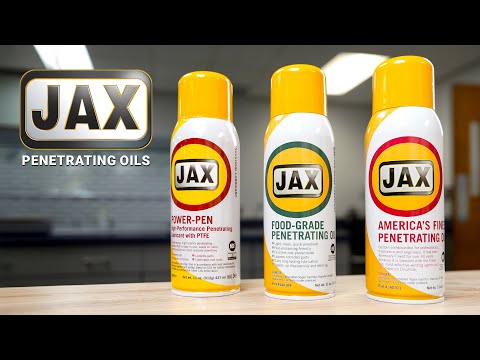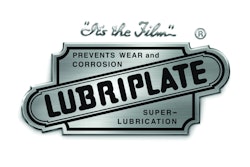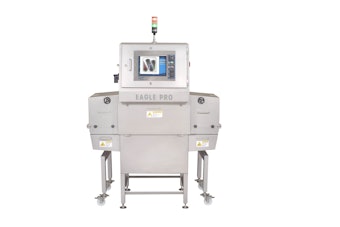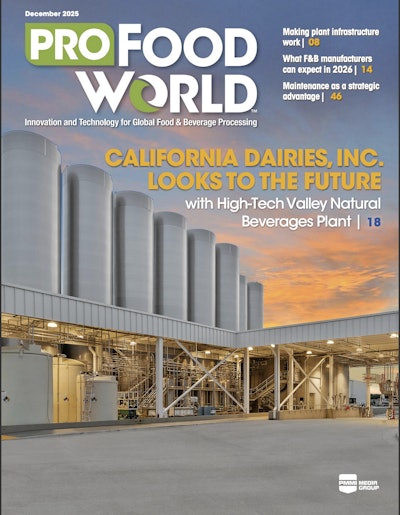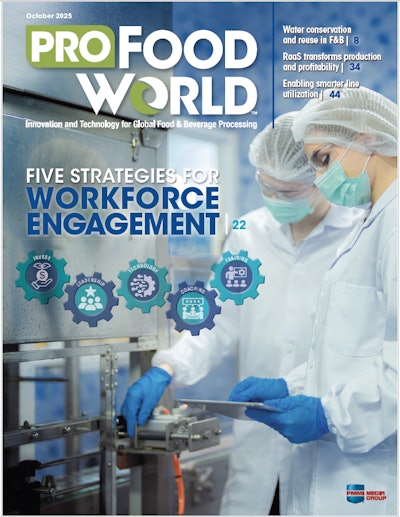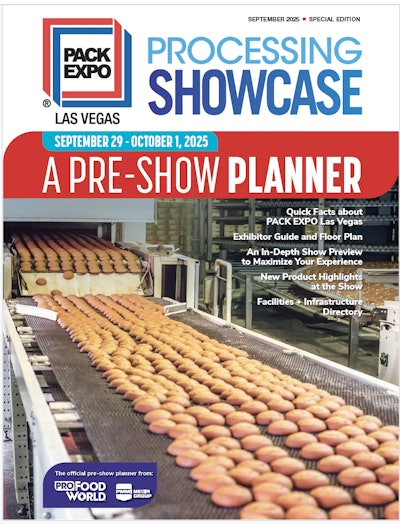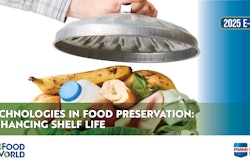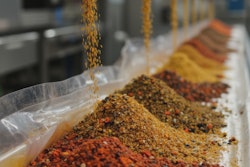If you still think food-grade lubricants can’t stand up to the rigorous demands of food and beverage manufacturing plants as compared to their industrial counterparts, think again. Dramatic advancements in food-grade oils, greases and sprays mean manufacturers no longer have to choose between performance and safety. Today’s food-grade lubricants are helping plants enhance production efficiency and extend the lifecycle of equipment while reducing the risk of lubricant contamination to food and beverage products.
Many food and beverage manufacturers consider lubricants to be the lifeblood of their plants. Proper lubrication prevents metal-to-metal contact and creates a separation among the components within a piece of machinery, helping to ensure the equipment operates safely, reliably and efficiently. Lubricants protect the moving parts and solid surfaces of equipment by reducing wear, friction, corrosion, deposits and oxidation; dissipating heat; and transferring power.
But lubricants can also pose a food safety risk. With the abundance of lubricated machinery in a plant, the likelihood of a lubricant dripping from a chain or escaping through a leak in a cable, for instance, is highly possible. FDA prohibits any food contamination by nonfood-grade lubricants. To prevent this type of contamination, many regulatory agencies and lubricant suppliers recommend that food and beverage processors use food-grade lubricants certified by NSF International, an independent nonprofit organization that specializes in standards development, product certification, education and risk management for public health and safety.
NSF International, the primary certification agency for lubricants used in food and beverage plants, groups lubricants into three main categories:
• H1 lubricants are classified as food-grade lubricants. Made of refined synthetic oils, USP white oil and/or vegetable stocks, they are edible, safe and nontoxic. If these food-grade lubricants fall into food or beverages on the processing line, the lubricants won’t affect the taste, smell or color of the products. H1 lubricants are approved for incidental contact with food, with FDA limiting food contact of H1 lubricants to 10 ppm.
• H2 lubricants cannot have any contact with food under any circumstances. Because these industrial lubricants are usually made of petroleum and other base stocks that are toxic when ingested, they can only be used in closed systems or where there is no chance of food contact.
• H3 soluble or edible oils are typically used to clean and prevent rust on trolleys, hooks and similar equipment. The parts of the equipment that come into contact with the food product must be cleaned and free of the oil prior to reuse.
Evolutionary tale
Today, H1 lubricants are considered the gold standard because they often equal or surpass the performance of industrial-grade lubricants while ensuring food safety. But it wasn’t always so. When they first were introduced, food-grade lubricants didn’t fare well in the harsh operating conditions of food and beverage plants, providing less protection and shorter lubricant life than industrial lubricants. For example, many food-grade lubricants couldn’t hold up to washdowns or steam, forcing manufacturers to lubricate the equipment frequently, according to Jim Girard, executive vice president and chief marketing officer for Lubriplate Lubricants Company.
“Throughout the ’60s and into the ’70s, [food-grade lubricants] were not good products because some of the additives that we’re using now were not available in the ’60s and the ’70s. They caused a lot of machinery downtime, and customers became very, very leery of using them with good reason,” Girard says. “As the technology evolved though, H1 lubricants [now] rival the performance of general industrial lubricants.”
“When we speak about H1 products even 20 years ago, you couldn’t expect the H1 product to be superior to the [H2] industrial product. The performance just didn’t stand up to industrial lubricants,” concurs Marius Czech, food market manager at Klüber Lubrication. “This is not the case nowadays. We put a lot of research and development in these H1 products to make them perform as good as the industrial greases.”
Suppliers have made significant advancements in H1 lubricants by enhancing the performance characteristics of their additives, base oils and thickeners — the three main components that comprise lubricants. They have strengthened the molecular structure of these components to prevent or minimize damage that typically plague food and beverage equipment, including corrosion, growth of micro-organisms, degradation, wear, friction, thermal buildup, oxidation and extreme pressure, while ensuring food safety.
“The molecular chain of food-grade lubricants is so much more stable now because of the way they’re put together,” says Ike Trexler, CLS, industry manager for the food and beverage industry at Summit. “Because most H1 lubricants are man-made now, every one of every molecule is just like the one before it. So they’re all very uniform, and that makes it much more stable.”
“H1 lubricants have gotten a lot better with recent technology trends. If you look at a food-grade lubricant and how it’s formulated today compared to 20 or 30 years ago, it’s night and day,” says Darren Lesinski, technical product director for Total Lubricants. “As a formulator, we have access to more additives and base oils and better understand different chemistries that we can use to enhance their performance, [while] still being safe to the consumer and in the manufacturing facility.”
Critical criteria
H1 lubricants on the market today fall into two primary classifications: mineral oil-based lubricants and synthetic lubricants. Most of the improvements in food-grade lubricants have occurred with synthetics — typically using esters and olefins — making them last longer and ideal to contend with a variety of tough operating conditions in a plant. Because they are highly refined, synthetic lubricants are more expensive. Mineral-oil based lubricants, on the other hand, are not as refined as synthetic lubricants. That makes them a cost-effective option for parts of a plant that have more moderate environments, such as ambient temperatures and smaller loads.
Operating temperature is one of the most important factors in determining what type of H1 lubricant to use. Mineral oils are acceptable for machinery like hydraulic systems that operate at temperatures between 120°F to 150°F. If mineral oil is used in temperatures above that range, it will oxidize and break down, creating carbon deposits that are abrasive to the mechanical components of the equipment. Most suppliers also don’t recommend using mineral oil for applications with freezing temperatures. “Mineral oil has a little bit of wax left in it. So that wax acts like a seed, and it starts to grow crystals as the oil cools down,” says Chris Foti, technical director for JAX.
Unlike mineral oils, synthetic lubricants tolerate both high and low temperatures. Polyalphaoelfins (PAO) are the most popular type of synthetic lubricant used in food and beverage plants because they can operate in temperatures ranging from as low as -50°F to as high as 325°F. In addition, they provide a high viscosity index and hydrolytic stability. PAOs are also miscible with mineral oils without any adverse effects on the lubricant or equipment.
“You wouldn’t necessarily want to do it on purpose, but one of the benefits of PAOs would be if they’re unintentionally mixed with mineral oils,” says Mitch Clark, western region sales manager for JAX. “Let’s say someone has a transfer container with PAO that they used to fill a component, and then they go back to the storage room and refill it with a mineral oil and they didn’t empty it completely. You’re not going to have an issue because they’re compatible.”
Like PAOs, polyalkylene glycol (PAG) synthetic lubricants can be used in both low- and high-temperature environments. But PAGs can work for applications that surpass the PAO high-temperature threshold of 325°F, up to about 425°F to even 500°F. Compared to PAOs and mineral oils, PAGs have excellent lubricity (low co-efficient of friction), extreme pressure protection, higher viscosity index, and better thermal and oxidative stability, resulting in longer lubricant life. They are even water soluble at ambient temperatures. However, they are not compatible with PAOs and mineral oils, and PAGs are also much more expensive than PAOs.
Due to their steep price tag and incompatibility with other lubricants, PAGs are best suited for equipment and components that are difficult to access, according to many suppliers. Because PAGs are high-performing, long-life lubricants, manufacturers will only have to replace them annually or once every two years. “It saves you labor, and it saves your disposal expense,” Clark says.
For applications that generate heat above 425°F, Foti recommends using synthetic ester-based lubricants, which are ideal for chains in pizza ovens, for example. “[Synthetic esters] have very good cleanliness and oxidative stability at the higher temperatures,” Foti says.
Viscosity is another important consideration when choosing a lubricant. The speed of the equipment’s components will determine whether to select a high- or low-viscosity lubricant. In general, fast-moving parts require a low-viscosity lubricant that can keep up with the speed and prevent thermal buildup from the heat generated. On the other hand, slow-moving parts need a heavy, thicker lubricant to maintain adequate separation between the parts.
“Viscosity is the key parameter in wear protection and efficiency,” says Neil Buchanan, senior technical advisor for Petro-Canada Lubricants. “If it’s a hydraulic system and you have too light of a viscosity, you will get a lot of leakage. If it’s too heavy, you can actually get cavitation and excessive heating. So viscosity is our primary criteria, the No. 1 thing you have to get right in a lubricant.”
Gaining momentum
As food and beverage plants become more automated and increase production capacity, they will need lubricants that can keep up. Many suppliers are heeding the call by developing innovative lubricants that meet the needs of today’s manufacturing facilities.
One of those developments include food-grade greases that can handle harsh washdowns. Many suppliers have created H1 greases thickened with calcium sulfonate, which offers protection from corrosion and rust. For example, Summit’s SumTech FGCS grease is thickened entirely with calcium sulfonate, which allows for superior water spray-off and water wash-off properties, Trexler says. “Calcium sulfonate separates the water from the grease,” he says. “It’s a much stronger grease than a grease with [conventional] aluminum complex [thickener]. The grease stays useful longer. It leads to longer lube intervals. Every application is different, but you probably get twice the life out of it with no problem.”
Petro-Canada Lubricants’ PURITY FG Synthetic Greases also contain calcium sulfonate. They not only provide strong resistance to water, but they can operate under broad temperatures and conditions. This allows manufacturers to consolidate the number of lubricants they use. “They’re an excellent multipurpose grease,” Buchanan says. “They have a number of really good properties. They naturally offer corrosion resistance, so they’re a very, very good choice in wet applications. And the thickener itself gives it anti-wear and extreme pressure properties.”
Total Lubricants also offers manufacturers the opportunity to consolidate and streamline their lubricant inventory with its Total Nevastane EP line, which protects a variety of equipment against high loads. It can be used in reciprocating air compression, gears and chains, for instance. “It’s a semisynthetic, contains advanced base oil and additive chemistry that starts at ISO grade 100 and goes up to ISO grade 680,” Lesinski says. “It’s a multiuse lubricant for across the board if manufacturers want to consolidate and get high performance, but also not pay the full price of a synthetic.”
Another innovation in food-grade lubricants is the emergence of anti-microbial formulations. Because food-grade lubricants can sometimes hold on to food or water during production or washdown, bacteria can grow on the lubricant, degrading the lubricant and putting the food or beverage product at risk for contamination. Lubriplate developed LUBRI-ARMOUR, an anti-microbial additive registered with the Environmental Protection Agency (EPA) that prevents the decomposition of lubricants caused by micro-organisms. Petro-Canada Lubricants’ PURITY FG2 with MICROL MAX grease is formulated with an EPA-registered anti-microbial product preservative designed to protect the lubricant from deterioration, fouling and odor caused by micro-organisms.
Besides micro-organisms, a potential problem in food and beverage plants is flammability given that many facilities operate at high temperatures. So JAX developed Pyro-Flow FG 46, a biodegradable, fire-resistant food-grade synthetic lubricant for hydraulic and circulation systems. The formulation consists of synthetic esters and a specifically engineered additive system. It has earned FM approval, which means the lubricant has met the highest standards for prevention and safety set by the independent testing agency of Factory Mutual (FM) Global, an American mutual insurance company. With FM approval status on this lubricant, food and beverage manufacturers reduce the costs of their liability insurance.
“A lot of the fire-resistant hydraulic fluids in the food industry use water glycol. The problem with those is you continually have to adjust your pH and water concentration. And because they’re water based, they have very poor anti-wear properties, so you wear out hydraulic pumps really quick,” Foti says. “We developed an ester-based product that is FM Global approved for fire resistance.” These lubricants can extend the life of pumps dramatically because they’re able to provide a better lubricating film, he adds.
Having it all
With the advancements in food-grade lubricants, suppliers recommend that food and beverage manufacturers transition their facilities to use only H1 lubricants, eliminating all H2 industrial lubricants from their plants. Many manufacturers are moving in that direction, but some are still following the old-school approach of “above the line, below the line,” according to suppliers. This method lets manufacturers use H1 lubricants above the production line, where food-grade lubricants may fall into food products. H2 lubricants, which are less expensive than H1 lubricants, are placed in equipment below the production line, where the risk of the industrial lubricants contaminating food is small. However, suppliers warn that approach could still lead to contamination. For example, lubricants could still splash up into the product. Or a worker could mistakenly fill a piece of equipment that requires H1 lubricant with H2 lubricant. To keep the entire facility safe and demonstrate compliance with the Food Safety Modernization Act, plants should use entirely H1 lubricants, suppliers say.
“Lubricants have a significant potential to have incidental contact with the food or beverage,” Girard says. “If you convert to 100 percent H1 food grade program, you are doing something to help your company and also you're improving the safety for the consumer.”
“Safety is No., 1. And I cannot understand a company trying to be food safe and not converting an entire plant to food lubricants,” Trexler says. “Why would you only do it partially? It's like partially painting your house.
“It’s also about value,” he adds. “Can you afford not to use food grade lubricants if you get inspected and get your plant shut down? Can you afford not to do that? When you look at it in those terms, it makes the oil and grease look pretty cheap.”
Learn more about the latest lubricant technology at PACK EXPO Las Vegas from Sept. 23-25 at the Las Vegas Convention Center. Register by Aug. 30 to save 70 percent off the registration fee.





